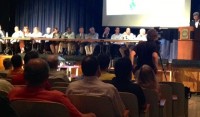Gedney Assoc. Holds City-wide Neighborhoods Meeting, Focus Turns to FASNY

About 375 residents representing neighborhoods across White Plains came out Wednesday, June 4, for an informational meeting at White Plains High School.
Called “White Plains at the Crossroads,” the Gedney Association Board presented five speakers who touched on topics of non-residential development at different locations within the city, but the main focus was the French American School of New York’s (FASNY) application for a special permit to run a regional school and campus within the Gedney single-family neighborhood zone and the possible closing of a portion of Hathaway Lane to accommodate a traffic plan proposed by the school.
In addition to the Gedney Association, the meeting was sponsored by North Street, Havilands Manor, Rosedale, Wyndham Close, Club Pointe, Glenbrooke and Maplemoor Pond neighborhood associations.
During audience Q&A Ken Krystal, President of the Carhart Association said his neighborhood had given unanimous support to the Gedney Association regarding its opposition to the FASNY proposal.
The Carhart Association faces its own fight with Sunrise Detox, which was turned down in its attempt to open a drug and alcohol rehabilitation center in the close-in residential Carhart neighborhood, but litigation is pending.
Terence Guerriere, President of the Gedney Association opened the evening by saying: “We feel abandoned.”
Referring to the White Plains Common Council, Guerriere and the entire Gedney Board contend that by accepting the FASNY Final Environmental Impact Statement (FEIS), the city’s zoning ordinance was deliberately twisted and the impartiality and objectiveness of the elected officials on the Council lost.
Guerriere urged everyone to attend the opening of the FASNY Special Permit and demapping of a portion of Hathaway Lane public hearings on July 7 at the regularly scheduled monthly meeting of the Council.
Information about the FASNY application was posted to the White Plains city website this week and can be read by visiting http://www.cityofwhiteplains.com/CivicAlerts.aspx?AID=54.
Bob Stackpole, on the Gedney Board and a member of the White Plains Planning Board, discussed the lawsuit the association had filed against the city, mayor and five members of the Council for their votes in favor of the FASNY FEIS.
The one Councilmember not mentioned in the suit is Milagros Lecuona who voted against acceptance.
“The city has violated common sense practice of SEQR (State Environmental Quality Review) law,” Stackpole said. “They have been arbitrary and capricious.”
Stackpole also said that FASNY has had 100 percent access to the city administration and to information, while the city had withheld information from the neighborhood association.
Regarding the placement of an access driveway onto the FASNY property from North Street, Stackpole said the conservancy proposed by FASNY would be “eviscerated” by that addition and questions the ability to place a roadway within a known wetlands area.
John Sheehan, who Guerriere credited with the idea to hold the informational meeting, and who was a main driver in pulling it all together, is also on the Gedney Board. As a life-long resident of White Plains and with a background in planning and commercial real estate, Sheehan said he felt qualified to dispel two myths that have been promulgated about the FASNY plan.
The first, which he credited to Mayor Tom Roach, is the contention that “you can’t turn down a school.” The second is that “FASNY parents will buy our homes.”
Sheehan believes the FASNY development would negatively impact the residential neighborhood in which it resides because there already is an over abundance of institutional development in the immediate area, and the case could be made legally to halt the school’s development.
There is a delicate balance of land use in White Plains he said. “I am afraid that is about to change.”
Sheehan further said that FASNY is not the enemy in this situation, rather it is the mayor and a few of the Common Council members and he recommends making this a political issue to gain votes on the Council in favor of the neighborhood.
Allen Flissler, one of the Association speakers supported Sheehan’s comment about FASNY parents not purchasing homes. “Families of private regional schools do not buy homes, they rent,” he said.
Other speakers talked about the potential negative impact of FASNY on the White Plains High School, the insufficient traffic plan, road safety for students who walk and bike to school, and dropping property values.
Of particular significance to the audience was a traffic map that showed the impact area of FASNY affecting a more than three-mile radius within White Plains, or about one-third of the city.
There was no response from government officials or FASNY representatives at the meeting.
A request for clarification from the Mayor’s Office about the legality of not being able to disallow a school a special permit to develop in a residential zone has not yet been answered.
Visit http://www.cityofwhiteplains.com/CivicAlerts.aspx?AID=54 for FASNY special permit information as posted on the City of WhitePlains website.
